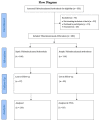Septic History Limits the Outcome of Tibiotalocalcaneal Arthrodesis
- PMID: 37240528
- PMCID: PMC10219404
- DOI: 10.3390/jcm12103422
Septic History Limits the Outcome of Tibiotalocalcaneal Arthrodesis
Abstract
Joint destruction necessitates tibiotalocalcaneal arthrodesis (TTCA) in cases of clinical deficits that cannot be controlled conservatively, possibly leading to sepsis. We aimed to compare the underlying etiology of posttraumatic joint destruction and the outcomes after TTCA in patients with a septic or aseptic history. Between 2010 and 2022, 216 patients with TTCA were retrospectively enrolled (septic TTCA (S-TTCA) = 129; aseptic TTCA (A-TTCA) = 87). Patient demographics, etiology, Olerud and Molander Ankle Scores (OMASs), Foot Function Index (FFI-D) scores, and Short Form-12 Questionnaire (SF-12) scores were recorded. The mean follow-up period was 6.5 years. Tibial plafond and ankle fractures were the most common causes of sepsis. The mean OMAS was 43.0; the mean FFI-D was 76.7; and the mean SF-12 physical component summary score was 35.5. All the scores differed significantly between the groups (p < 0.001). With an average of 11 operations until the arthrodesis was achieved, the S-TTCA patients underwent about three times as many operations as the A-TTCA patients (p < 0.001), and 41% of S-TTCA patients remained permanently unable to work (p < 0.001). The significantly worse results of S-TTCA compared to A-TTCA show the long and stressful ordeal that patients with a septic history suffer. Further attention must be paid to infection prophylaxis and, if necessary, early infection revision.
Keywords: ankle arthrodesis; hindfoot fusion nail; posttraumatic septic osteoarthritis; septic history; tibiotalocalcaneal arthrodesis.
Conflict of interest statement
The authors declare no conflict of interest.
Figures




References
-
- Cibura C., Lotzien S., Yilmaz E., Baecker H., Schildhauer T.A., Gessmann J. Simultaneous septic arthrodesis of the tibiotalar and subtalar joints with the Ilizarov external fixator-an analysis of 13 patients. Eur. J. Orthop. Surg. Traumatol. 2022;32:1063–1070. doi: 10.1007/s00590-021-03075-0. - DOI - PMC - PubMed
LinkOut - more resources
Full Text Sources

